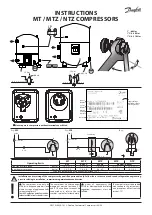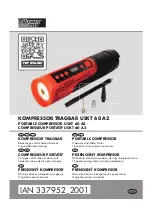
Application guidelines
44
FRCC.PC.014.A4.22
Installation
Tubing
Filter driers
Copper to copper connections
Dissimilar metals connections
Brazing and soldering
Only use clean and dehydrated refrigera-
tion-grade copper tubing. Tube-cutting must
be carried out so as not to deform the tubing
roundness and to ensure that no foreign debris
remains within the tubing. Only refrigerant grade
fittings should be used and these must be of
both a design and size to allow for a minimum
pressure drop through the completed assembly.
Follow the brazing instructions bellow. Never drill
holes into parts of the pipe-work where filings
and particles can not be removed.
For new installations with VSH compressors with
polyolester oil, Danfoss recommends using the
Danfoss DML 100% molecular sieve, solid core
filter drier. Molecular sieve filter driers with loose
beads from third party suppliers shall be avoided.
For servicing of existing installations where acid
formation is present the Danfoss DCL solid core
filter driers containing activated alumina are
recommended.
The drier is to be oversized rather than under-
sized. When selecting a drier, always take into
account its capacity (water content capacity),
the system refrigeration capacity and the system
refrigerant charge.
When brazing copper-to-copper connections, the
use of copper/phosphorus brazing alloy contain-
ing 5% silver or more with a melting temperature
of below 1500°F is recommended. No flux is
required during brazing.
When manipulating dissimilar metals such as copper and brass or steel, the use of silver solder and
anti-oxidant flux is necessary.
The use of highly hygroscopic polyolester oil
in R410A compressors requires that the oil be
exposed to the atmosphere as little as possible.
System contamination is one of main factors
affecting equipment reliability and compressor
service life. It is important therefore to take sys-
tem cleanliness into account when assembling a
refrigeration system.
During the manufacturing process, circuit con-
tamination may be caused by:
• Brazing and welding oxides,
• Filings and particles from the removal of burrs in
pipe-work,
• Brazing flux,
• Moisture and air.
Consequently, when building equipment and as-
semblies, the precautions listed in the following
paragraphs must be taken.
System cleanliness
The refrigerant compression system, regardless
of the type of compressor used, will only provide
high efficiency and good reliability, along with a
long operating life, if the system contains solely
the refrigerant and oil it was designed for. Any
other substances within the system will not
improve performance and, in most cases, will be
highly detrimental to system operations.
The presence of non-condensable substances
and system contaminants such as metal shavings,
solder and flux, have a negative impact on com-
pressor service life. Many of these contaminants
are small enough to pass through a mesh screen
and can cause considerable damage within a
bearing assembly.
When brazing the compressor fittings, do not
overheat the compressor shell, which could se-
verely damage certain internal components due
to excessive heating. Use of a heat shield and/or a
heat-absorbent compound is highly recommend-
ed. Due to the relatively sizable tubing and fitting
diameters a double-tipped torch using acetylene
is recommended for brazing operation on VSH
compressors.
B
C
A
heat shield
Compressor connection















































